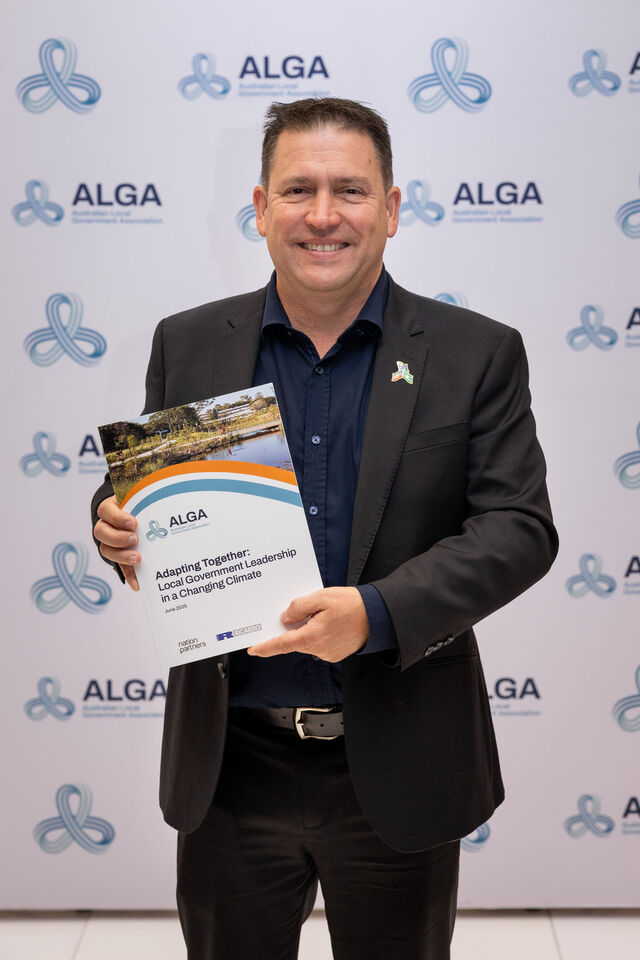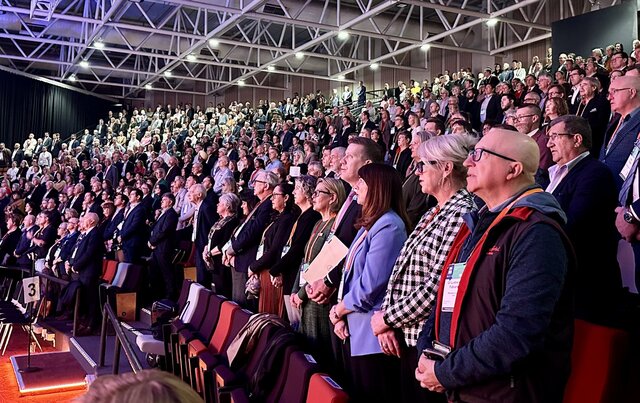Councillor Clayton Hawkins, Waratah-Wynyard Council, Tasmania
Q. How long have you been on Council?
Since October 2009. I was voted in very convincingly in second place out of 13 candidates running for five positions. I was very happy with this, as I was a first time candidate. It does help having a high public profile, which has been built from me being a musician, a media hogging academic and a former Local Government employee who worked with hundreds of community members. I ran a very strong social media strategy with my campaign and I think that helped too.
Q. You were previously employed within Local Government for six years. What roles did you take on during that period and did this influence your decision to run for Council?
I was employed by Burnie City Council in 2001 as the inaugural Cultural Development Officer. This role saw me work with hundreds of community groups and many more passionate individuals to enhance their activities, as well as managing many cultural events and programs. In 2005 my role changed to Community and Recreation Officer, involving managing wider community projects and overseeing recreation facilities and programs within the Burnie Municipality.
This experience influenced my decision to run for Council. I’d been wanting to run since 2001, but I felt that working for a neighbouring council, which had had past discussions on amalgamation and resource sharing with Waratah-Wynyard Council, could cloud things. Spending six years ‘on the inside’ and writing many reports for Council agendas has given me a very solid background to become a Councillor.
In 2007 I moved to the University of Tasmania’s Institute for Regional Development, where I am currently a lecturer, degree coordinator of the Bachelor of Regional Resource Management, and a PhD candidate. This freed me up, political wise, to run for Council.
Q. As a sixth generation Waratah-Wynyard local, what do you think has kept your family in the area for so long?
We love the place – simple as that. The air is fresh, the water tastes great, people are sociable and you can make a real difference. I am Wynyard born and bred, but like many young people, I moved away. I returned eight years later with renewed enthusiasm and appreciation of the place, but brought back my own experiences to take advantage of.
We are a passionately community minded family, who for several generations has not been scared to argue for social equity. My now deceased grandfather is a former Waratah-Wynyard Citizen of the Year. In my election campaign, I received some votes purely on the respect that my ancestors here had built – to sum it up, one quote from a senior member of the community that makes me smile is, “your grandfather was a good bloke, so I guess you are too”.
Q. Your involvement in the Who’s DES Tonight? Designated Driver program and Recording Artists, Actors and Athletes Against Drink Driving suggests you have a passion for arts and youth issues. Tell us about this.
I’m all about lifestyle. If you don’t have a liveable and diverse community, then how do you expect to adapt to this ever changing world?
Youth participation in society through an understanding of young people’s needs and wants is a key driver for me. Coming from a lower socioeconomic background and being a first in family university student drives me to make a difference and to open up opportunities for my children.
Q. Tell us about the PhD you are currently working on.
My PhD studies are based around the changing nature of leisure and social networking and the impact this will have on Local Government planning into the future. People are increasingly participating in leisure in more individualistic ways. What does that mean for local communities, as traditional community groups were once the bastion of social networking and ‘getting ahead’?
In the next 12 months, I’ll be undertaking studies of informal leisure spaces, such as skate parks, al fresco dining spaces, community event spaces and online social media web platforms to gain some insights into how multi user spaces could be used by policymakers as places for building social capital and keeping information flows going. I hope to influence public policy, especially Local Government bodies, as they are the predominant stewards of the liveability of their communities.
Being a Councillor is actually a good bit of field research.
Q. What do you hope to accomplish in the future?
I operate a blog at claytonjhawkins.blogspot.com, which was a promise I made when I ran for Council. I relate the use of it to a cricket analogy – the scorebook does not tell you how the batsman’s four was hit, it just simply says four. Council minutes do the same. I update my blog after every Council meeting to let the locals know why I voted a certain way to offer additional transparency in my decision making and to elucidate some of the discussion. I want people to become more engaged in Local Government, so if my blog can provide an insight into Council, then that’s awesome.
I want to see more young people involved in Local Government and I believe that the 2011 elections in my municipality will be very interesting in this space.
Alderman Christine Lucas, Glenorchy City Council, Tasmania
Q. How long have you been on Council?
I have been on Glenorchy City Council for 16 years. In that time, I have enjoyed working with the community on many projects.
Q. Why did you become involved in Local Government?
I became interested in Local Government following a planning issue in 1992. Glenorchy City Council was proposing to rezone Blacksnake Lane, where we live, from rural residential to high density residential building blocks. My husband and I worked with our neighbours to evaluate the supply of land between Granton and Hobart, and considered all sorts of factors, such as water, sewerage, public transport, public open space and the future needs of the community.
At the time we were told that our best chance of success would be to do our homework on planning issues and present a well researched case, rather than jumping up and down in an emotive way. This proved to be excellent advice, as we were able to prove that there was a plentiful supply of land, and it wasn’t necessary to extend the urban sprawl this far.
Blacksnake Lane has since been rezoned, but to larger blocks. The sewerage has come and it is still one of the best places to live in the City.
Q. Tell us about your day job.
My day job is in the tourism industry as Director of Sales and Marketing for Mercure Hotels in Hobart and Launceston. Being a part of the Accor group of hotels has given me the opportunity to improve my skills and knowledge, while working to raise awareness of Tasmania and to increase business visitation in the State. It has also made me more passionate about promoting Council’s tourism opportunities.
Glenorchy City has the most amazing tourism products, including Cadbury Chocolate factory and the Moorilla Winery, which includes MONA – the Museum of Old and New Art. It is yet to be opened, but will increase worldwide recognition of Tasmania, and Glenorchy in particular.
Working on events such as The Works Festival, Symphony Under the Stars and Carols by Candlelight has also been very rewarding.
Being a member of the Glenorchy Visitor Taskforce has given me the opportunity to be involved in the development of tourism for the greater Hobart region, which benefits us all and has huge potential for increased visitation.
Q. What other issues are important to you?
The health of our community is important to me, particularly mental health. Lobbying to provide services that meet the needs of the people in our community who are marginalised and who do not have a voice is crucial.
I would like to think that moving forward as a community, we can be successful in making Glenorchy, and Tasmania as a whole, a safe and welcoming place for young people who experience mental health problems from time to time.I look forward to the day when agencies such as Mental Health Services, Housing Tasmania, Tasmania Police and the Royal Hobart Hospital work more closely together to find better mental health solutions and shorten times for access to suitable public housing.
Q. What innovative projects or policies is Glenorchy City working on?
Water and sewerage changes have impacted on Local Government in Tasmania. Glenorchy City is working on new financial modelling and strategies to work within the new environment.
A major project is the development of the New Planning Scheme for Glenorchy.
Q. What has been your greatest achievement on Council?
There have been many that are highlights. I am currently Deputy Chair of the Planning Authority and working with both applicants and representors to get balanced outcomes; I was elected as Council’s representative on the Southern Tourism Taskforce and was then elected Chair of the Regional Events committee, which developed the Regional Events Strategy for Southern Tasmania; and I am Council’s representative on the Local Tourism Taskforce.
I have also been Council’s representative on Discover Claremont promotions for
10 years, working with traders to develop the local community shopping centre precinct and grow local business; and I am a member of the Granton and Austin’s Ferry Precinct, leading to involvement with events like the KITE Festival.
Q. What do you like most about the Glenorchy area?
Our people and our place. Glenorchy is a great place to live and we have amazing people in our community who actively participate in Council and the community. They are the fabric of the City. The location of our City is fantastic along the banks of the beautiful Derwent River and under Mt Wellington. If you have not been you should. Visit us soon: now is a great time to travel to Tasmania and Glenorchy.







